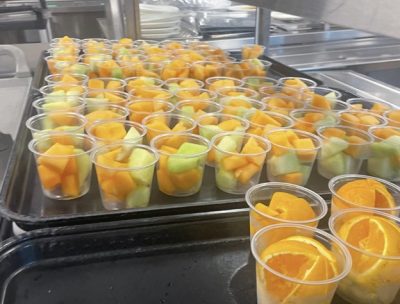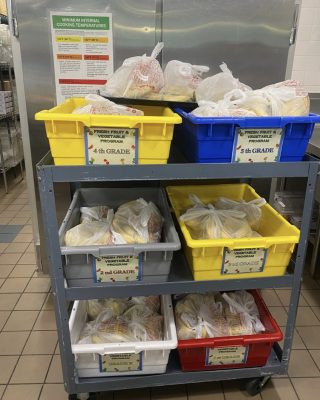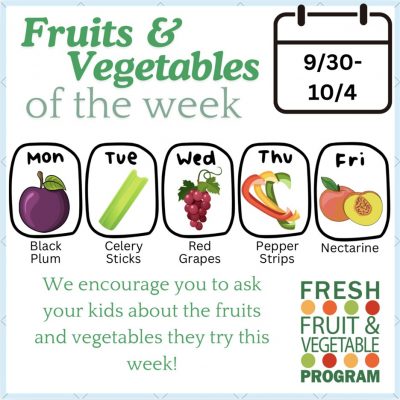The Fresh Fruit and Vegetable Program (FFVP) is a USDA program that offers fresh fruits and vegetables to elementary school-age children in qualifying low-income school districts. Produce is distributed in the classroom outside of school meals to give children exposure to a variety of fruits and vegetables to ultimately improve healthy nutrition behaviors and support child health.
distributed in the classroom outside of school meals to give children exposure to a variety of fruits and vegetables to ultimately improve healthy nutrition behaviors and support child health.
UConn Healthy Family CT and the UConn Dietetics Program partnered with the Connecticut State Department of Education’s Fresh Fruit and Vegetable Program and five qualifying Connecticut school districts to help those districts implement high quality, effective FFVP programs.
Research shows that nutrition education coupled with FFVP is critical to impact child fruit and vegetable consumption. One specific goal of our collaboration was to help districts provide nutrition education along with FFVP.
After interviewing school food service directors and working with local FFVP school districts, we are excited to share:
- FFVP nutrition education materials
- FFVP video resources for teachers and school administrators
- FFVP best practices
Nutrition Education Materials
Our team created interdisciplinary nutrition education materials that can be used in the classroom, including fun facts sheets, coloring pages, writing practice sheets, math handouts, and more! We have resources available for 38 fruits and vegetables.
If you are interested in FFVP nutrition education materials, please contact healthyfamilyct@uconn.edu and we will provide a link to our materials.
Other helpful resources for FFVP nutrition education materials include:
Video Resources
Our team created two informational videos – one for teachers and one for school administrators.
The video for teachers explains how to conduct a sensory taste test in the classroom. Sensory taste tests are simple, easy, and help engage children in the tasting process.
The video for school administrators explains helpful information that may be needed when starting FFVP at your school, as well as the benefits of the program.
Video for School Administrators
Best Practices
Recommendations for Produce Procurement & Preparation
- Source Local Produce. Prioritize locally sourced food to improve produce freshness and quality. We found that districts that sourced from suppliers at a greater distance dealt with produce spoilage and poor produce quality and acceptability. Local produce travels fewer miles with less opportunity and time for spoilage.
- Use Strategic Menu Planning. Use menu planning strategies to maximize produce freshness. For example, schools can serve produce with a lower shelf life closer to delivery and produce with a longer shelf life further from delivery. When planning the menu, consider using some produce that has been prepackaged with other produce that needs further preparation. Prepackaged produce reduces the preparation burden on cafeteria staff. While whole produce adds labor for cafeteria staff, it would likely improve student satisfaction due to higher freshness. Balance of both prepackaged produce and produce that needs further preparation reduces cafeteria staff burden while increasing student satisfaction.
- Coordinate with School Meals. Consider coordinating FFVP produce with offerings from the school menu to reduce preparation time. Cafeteria staff can prepare and package produce for FFVP at the same time as preparing produce for school meals, reducing the burden of FFVP preparation.
Recommendations for Produce Distribution
- Keep Food Safety First. Prioritize strategies for food safety with produce distribution. To avoid the distribution of extra produce to homes, especially cut produce that poses a safety risk due to sitting outside of refrigeration for extended periods of time, food safety posters should be used in classrooms. Teachers should be educated on food safety and reminded that produce should be consumed in the classroom. No leftover produce should be sent home with children.
- Label Produce Bins. Bin labeling systems worked well to
 organize produce distribution by classroom. Allergies can be added to bin labels to ensure students with allergies avoid the respective produce.
organize produce distribution by classroom. Allergies can be added to bin labels to ensure students with allergies avoid the respective produce. - Consider School Needs and Ability. Consider each school’s needs in terms of who distributes produce and when. Potential distributors may be teachers, cafeteria staff, or students. Potential pick-up times may be morning, lunch, or afternoon. Teachers can be reminded that produce picked up in the morning should be consumed before lunch to avoid quality and spoilage issues.
Recommendations for Education
- Keep Education Simple and Sensory-focused. Use simple nutrition education approaches in the classroom. Straightforward content, such as fun facts, takes less time to communicate and reduces the burden on teachers of long or complicated lessons. Teachers can instead focus on engaging students’ senses during produce tasting, helping students explore colors, textures, smell, and taste. Including a simple statement that reinforces produce healthfulness while encouraging tasting can increase child consumption of fruits and vegetables during produce distribution.
- Equip Teachers for Education. Provide teachers with clear expectations, training, and resources to ensure students receive consistent nutrition education. Teachers should be aware of their role in FFVP through newsletters, announcements, and trainings. Trainings should focus on educating on the benefits of FFVP, role of teacher modeling during FFVP service, and engaging students’ senses during tasting. We encourage providing simple resources such as fun facts, coloring sheets, and activities that tie food education to other curricular requirements. For example, students can do “veggie math” by counting carrots or other produce.
- Employ Creative Strategies. You may need to explore creative strategies to reach students with nutrition education, especially where teacher and administrative buy-in is low. For example, the cafeteria or morning announcements can be used for school-wide nutrition education.
Recommendations for Program Promotion
- Leverage Social Media. If the school district utilizes social media platforms, consider leveraging the social media access to expand program impact to the home and community.
 Social media posts can educate viewers on the benefits of produce and how to prepare fruits and vegetables, encouraging healthy eating in the home. Increased home awareness of FFVP can reinforce positive eating patterns for children.
Social media posts can educate viewers on the benefits of produce and how to prepare fruits and vegetables, encouraging healthy eating in the home. Increased home awareness of FFVP can reinforce positive eating patterns for children. - Spread Awareness of FFVP Benefits. Prioritize raising awareness on the benefits of FFVP to increase buy-in at all levels. Administrators should be made aware of the benefits of FFVP to understand the importance for child exposure to fruits and vegetables. Teachers and cafeteria staff should also be made aware of the importance of their role in contributing to positive student health outcomes through participation in FFVP.
- Promote Program to Parents. Ensure that parents are aware of the program and encourage parents to reinforce positive behaviors at home. For example, send home family-friendly recipes that use produce children have tried in FFVP – this continues the exposure of healthy food at home.
Recommendation for Program Evaluation
Gather Feedback. Regularly evaluate program effectiveness through surveys or conversations with food service staff, teachers, and students. Food service staff can provide feedback on the intensity of produce preparation and collaborations with teachers. Teachers can provide feedback on educational challenges, successes, and ideas for simple reinforcement strategies. Students can provide feedback on produce quality, flavor, and ideas to improve acceptability. With the input of the entire school, program engagement can be enhanced at all levels.
 organize produce distribution by classroom. Allergies can be added to bin labels to ensure students with allergies avoid the respective produce.
organize produce distribution by classroom. Allergies can be added to bin labels to ensure students with allergies avoid the respective produce. Social media posts can educate viewers on the benefits of produce and how to prepare fruits and vegetables, encouraging healthy eating in the home. Increased home awareness of FFVP can reinforce positive eating patterns for children.
Social media posts can educate viewers on the benefits of produce and how to prepare fruits and vegetables, encouraging healthy eating in the home. Increased home awareness of FFVP can reinforce positive eating patterns for children.